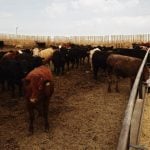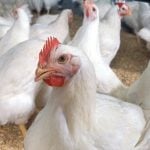Chicago | Reuters – Chicago Mercantile Exchange live cattle futures finished the week with losses as investors tweaked positions ahead of the U.S. Department of Agriculture monthly Cattle-On-Feed report at 2 p.m. CST (2000 GMT), said traders.
Analysts, on average, expect the report to show 7.7 percent more cattle were placed into U.S. feedlots last month than in October 2016.
December live cattle finished 0.700 cent per pound lower at 118.850 cents, and February ended down 0.450 cent to 124.675 cents.
Futures were further pressured by this week’s lower cash prices due to lackluster wholesale beef demand and plants shutting down over the Thanksgiving Day holiday.
Read Also

U.S. livestock: Cattle make gains, hogs mixed
Most Chicago cattle futures rose on Wednesday after Tuesday’s hard fall. Hogs settled on either side of unchanged. Most-active October…
Packers this week paid $118 to $120 per cwt for slaughter-ready, or cash, cattle that a week earlier brought $122 to $125, said feedlot sources.
Beef demand could mount a brief comeback as retailers buy product to avoid potential shortages as a result of holiday plant closures, a trader said.
Also, some consumers may turn to beef as an alternative to turkey after the Thanksgiving holiday, he added.
Sell stops, technical selling and lower live cattle futures pulled down CME feeder cattle contracts.
The CME said on Friday that USDA technical problems delayed feeder cattle futures and options settlement date, and option expiration.
While delayed USDA information did not help futures, most of the market sell-off was tied to concerns about Friday’s USDA Cattle-On-Feed report, said livestock futures trader Dan Norcini.
November feeder cattle closed down 2.175 cents per pound to 151.725 cents.
Firmer hog market close
CME lean hogs settled in positive territory, with support from short-covering before the weekend, said traders.
December benefited from its reduced price compared to the exchange’s hog index for Nov. 15 at 65.97 cents.
December hogs ended up 0.550 cent per pound to 60.650 cents. February closed 0.500 cent higher at 67.075 cents.
Futures rose despite the pullback in hog prices before the holiday-shortened workweek, which pressured cash prices for a sixth straight session, said analysts and traders.
Grocers that have most of their ham business done for Thanksgiving are waiting to see how product moves before restocking meat cases, they said.













